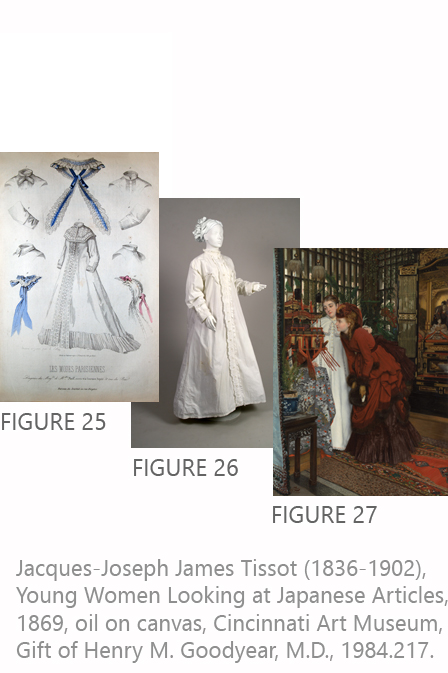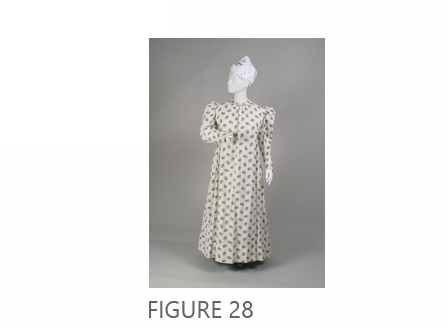Slipping Into Something More “Comfortable”
The home can be a symbolic place where notions of comfort, privacy, and domesticity influence human behaviour.1 For many, the home is a sanctuary, a place for respite, and where pieces of clothing worn in public can be shed. It is a space for privacy and intimacy. Some sections of the home address our social needs to entertain and build relationships, while others are personal retreats from the world. Privacy is the control of visibility and the basis of modesty.
Different body parts have traditionally been covered to ensure modesty in public spaces. Men have long worn undershirts and tank tops beneath white dress shirts to conceal their nipples. Conversely, some garments are designed to be worn in private with intent to reveal such features. Some clothing occupies a liminal space in between. The peignoir (Figures 25 & 26), a loose-fitting garment, was meant for intimate settings, however, the wearer had control over who would see her so adorned (Figure 27). During Victorian times, the modesty of a garment was intrinsically linked to its fit. Many loose-fitting dresses signified loose morals, therefore these styles were not considered appropriate outside the realm of one’s innermost circle.2 Due to its semi- or loose-fitted silhouette, the “wrapper” (Figure 28) was somewhere in between. It was intended for a private home setting, but could be acceptable when greeting unexpected guests. Certain loose-fitting dresses with long-sleeves and high necklines were deemed immodest in public, while other revealing styles, like ball gowns with plunging necklines, were not only acceptable but required in particular settings.
The provocative negligee is a garment traditionally worn only in the most private space of the home: the bedroom. While some styles use sheer fabrics alone or in layers to titillate but not reveal (Figures 29 & 30), recent “baby doll” styles are often less inhibited (Figure 31) and speak of changing mores. Various 20th-century designers have used the aesthetic of intimate attire in evening wear to push boundaries (Figures 32 & 33). The slip dress (Figure 34) is an example of this liminal phenomenon. By the 1990s, it left its underwear classification to become visible outside the dressing room. When private attire crosses the threshold to be seen in public, it is a demonstration of drastic changes in notions of modesty.
1 Zulkeplee Othman, Rosemary Aird, and Laurie Buys, “Privacy, modesty, hospitality, and the design of Muslim homes: A literature review,” Frontiers of Architectural Research 4, no. 1 (2015): 12. https://doi.org/10.1016/j.foar.2014.12.001.
2 Sally Helvenston Gray, “Searching for Mother Hubbard: Function and Fashion in Nineteenth-Century Dress,” Winterthur Portfolio 48, no. 1 (Spring 2014): 47. https://doi.org/10.1086/676031.
Curators
Anne Bissonnette, PhD, Bronwyn Bates, Rhonda Buie, Emma Carr, Juli Grombacher, Frances Heaton, Danielle Klatchuk, Evelyn Leung, Diana Leyva Luciano, Ariane Mendoza, Thomas Osterling, Nicole Morozewich, Emma Ross, and Chloe Schell.








